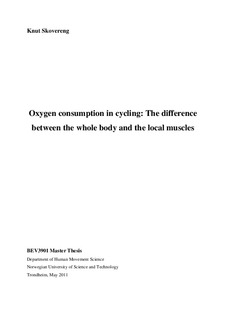| dc.contributor.advisor | van Beekvelt, Mireille | nb_NO |
| dc.contributor.advisor | Ettema, Gertjan | nb_NO |
| dc.contributor.author | Skovereng, Knut | nb_NO |
| dc.date.accessioned | 2014-12-19T14:44:26Z | |
| dc.date.available | 2014-12-19T14:44:26Z | |
| dc.date.created | 2011-08-11 | nb_NO |
| dc.date.issued | 2011 | nb_NO |
| dc.identifier | 433886 | nb_NO |
| dc.identifier.uri | http://hdl.handle.net/11250/271508 | |
| dc.description.abstract | Introduction: Oxygen consumption during exercise has been extensively studied with the focus primarily on whole body oxygen consumption (tVO2). The purpose of this thesis was to use Near-infrared spectroscopy (NIRS) to compare tVO2 to oxygen consumption in the local muscles (mVO2) at increasing work rate.
Method: 18 male cyclists performed an incremental cycling test until exhaustion. tVO2 was measured through pulmonary gas exchange and mVO2 was measured using NIRS in combination with arterial occlusion (AO). mVO2 was measured in the vastus medialis (VM) and vastus lateralis (VL) muscles. Results: tVO2 showed an linear increase with increasing work rate. However, tVO2 showed an initially faster increase followed by a slower increase with increased work rate when compared to tVO2. No increase in cadence was seen with increasing work rate.
Discussion: The main finding was a significant different effect of work rate on mVO2 and tVO2. The steep increase in mVO2 during low intensity exercise found in the present study indicates that the VM and VL muscles are activated at an early stage during increasing intensity. The results from the present study indicate that there are differences between what happens in the local muscle and what is observed when looking at the whole body. The increase in work rate with no observed increase in cadence may indicate increased intramuscular pressure which may occlude blood flow in the muscle and thus be part of the reason for the decrease in mVO2 seen at high intensity.
Conclusion: This study shows that care should be taken with results from tVO2 for practical application because the mechanisms at the local level are more complex and deviate substantially from that what you can derive from whole body measurements.
Key words: Near-infrared spectroscopy, cycling, local muscle VO2, mVO2, whole body VO2, tVO2, vastus lateralis, vastus medialis. | nb_NO |
| dc.language | eng | nb_NO |
| dc.publisher | Norges teknisk-naturvitenskapelige universitet, Fakultet for samfunnsvitenskap og teknologiledelse, Institutt for bevegelsesvitenskap | nb_NO |
| dc.subject | Social and Behavioural Science, Law | en_GB |
| dc.title | Oxygen consumption in cycling: The difference between the whole body and the local muscles | nb_NO |
| dc.type | Master thesis | nb_NO |
| dc.source.pagenumber | 30 | nb_NO |
| dc.contributor.department | Norges teknisk-naturvitenskapelige universitet, Fakultet for samfunnsvitenskap og teknologiledelse, Institutt for bevegelsesvitenskap | nb_NO |
